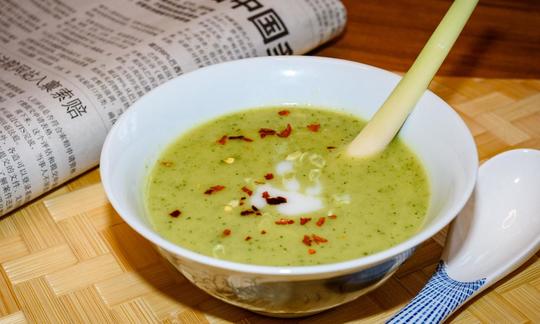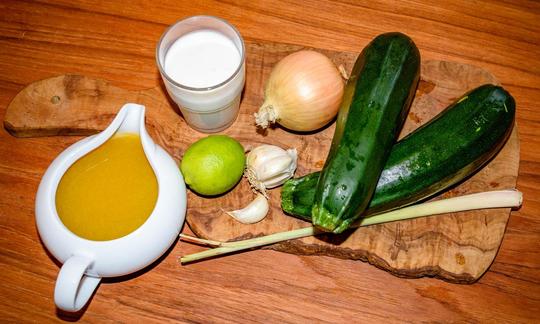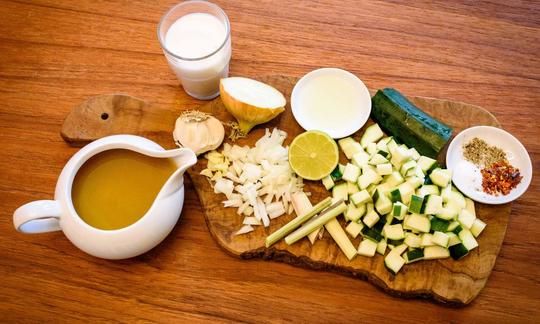Zucchini soup with lemongrass and lime juice
vegan
Ingredients (for servings, )
| 1 | Onions, raw (organic?) (3.9 oz) |
| 2 cloves | Garlic (organic?) (0.21 oz) |
| 1 kg | Zucchini, raw, (organic?) (35 oz) |
| 1 stalk | Lemongrass, West Indian or Guatemalan lemongrass (0.88 oz) |
| 1 tbsp | Rapeseed oil, refined (organic?) (0.49 oz) |
| 400 ml | Vegan vegetable stock, organic? (14 oz) |
| 200 ml | Coconut milk, raw (coconut milk, organic?) (7.1 oz) |
| 1 dash | Table salt (table salt, raw?, organic?) (0.01 oz) |
| 1 dash | Black pepper (organic?, raw?) (0.00 oz) |
| 1 tsp | Chili flakes (raw?, organic?) (0.16 oz) |
| 1 | Limes, raw (organic?) (2.4 oz) |
| 100 ml | Drinking water, raw (organic?) (3.5 oz) |
Equipment
- hand-held blender / immersion blender
- stove
- citrus juicer (lemon squeezer)
- saucepan
Type of preparation
- cook
- chop or grind
- squeeze
- sweat
- season to taste
- sauté
- purée
- deglaze
- remove the skin
- simmer
Preparation
Preparing the vegetables
Peel the onion and garlic and cut into fine cubes. Clean the zucchini and also dice. Cut the lemongrass into 3 pieces. Cut the middle part into very fine rings and put to one side. Flatten the other pieces with a blunt object (for example the handle of a knife or the bottom of a spoon).Preparation of the soup
Heat the oil in a large pan. First, fry the onion pieces until translucent. After about 2-3 minutes, add the garlic, zucchini and lemongrass and fry for about 5-10 minutes at a medium temperature, stirring occasionally. Deglaze with vegetable stock.Finishing the soup
Remove the lemongrass and puree the soup finely with a hand blender. Add the coconut milk, stir and bring to the boil briefly. The zucchini should now be cooked. Season to taste with salt, pepper, chili flakes and freshly squeezed lime juice. Add water as needed so that the soup is creamy but not thick. To serve, pour into soup bowls and sprinkle with fine lemongrass rings.
|
Nutritional Information per person
Convert per 100g
|
2000 kcal | |
|---|---|---|
| Energy | 235 kcal | 11.7% |
| Fat/Lipids | 17 g | 24.5% |
| Saturated Fats | 11 g | 56.5% |
| Carbohydrates (inc.dietary fiber) | 20 g | 7.6% |
| Sugars | 11 g | 12.0% |
| Fiber | 5.6 g | 22.3% |
| Protein/Albumin | 5.3 g | 10.6% |
| Cooking Salt (Na:90.0 mg) | 229 mg | 9.5% |
| Essential micronutrients with the highest proportions | per person | 2000 kcal | |
|---|---|---|---|
| Vit | Vitamin C (ascorbic acid) | 58 mg | 72.0% |
| Min | Manganese, Mn | 1.4 mg | 69.0% |
| Elem | Potassium, K | 998 mg | 50.0% |
| Vit | Folate, as the active form of folic acid (née vitamin B9 and | 90 µg | 45.0% |
| Vit | Vitamin B6 (pyridoxine) | 0.54 mg | 38.0% |
| Vit | Vitamin K | 27 µg | 35.0% |
| Min | Copper, Cu | 0.34 mg | 34.0% |
| Elem | Phosphorus, P | 182 mg | 26.0% |
| Fat | Alpha-Linolenic acid; ALA; 18:3 omega-3 | 0.46 g | 23.0% |
| Elem | Magnesium, Mg | 79 mg | 21.0% |
Detailed Nutritional Information per Person for this Recipe
The majority of the nutritional information comes from the USDA (US Department of Agriculture). This means that the information for natural products is often incomplete or only given within broader categories, whereas in most cases products made from these have more complete information displayed.
If we take flaxseed, for example, the important essential amino acid ALA (omega-3) is only included in an overarching category whereas for flaxseed oil ALA is listed specifically. In time, we will be able to change this, but it will require a lot of work. An “i” appears behind ingredients that have been adjusted and an explanation appears when you hover over this symbol.
For Erb Muesli, the original calculations resulted in 48 % of the daily requirement of ALA — but with the correction, we see that the muesli actually covers >100 % of the necessary recommendation for the omega-3 fatty acid ALA. Our goal is to eventually be able to compare the nutritional value of our recipes with those that are used in conventional western lifestyles.
| Essential fatty acids | per person | 2000 kcal |
|---|---|---|
| Alpha-Linolenic acid; ALA; 18:3 omega-3 | 0.46 g | 23.0% |
| Linoleic acid; LA; 18:2 omega-6 | 1.1 g | 11.0% |
| Essential amino acids | per person | 2000 kcal |
|---|---|---|
| Tryptophan (Trp, W) | 0.05 g | 20.0% |
| Threonine (Thr, T) | 0.14 g | 15.0% |
| Isoleucine (Ile, I) | 0.18 g | 14.0% |
| Lysine (Lys, K) | 0.26 g | 14.0% |
| Valine (Val, V) | 0.23 g | 14.0% |
| Leucine (Leu, L) | 0.30 g | 12.0% |
| Phenylalanine (Phe, F) | 0.19 g | 12.0% |
| Methionine (Met, M) | 0.07 g | 8.0% |
| Vitamins | per person | 2000 kcal |
|---|---|---|
| Vitamin C (ascorbic acid) | 58 mg | 72.0% |
| Folate, as the active form of folic acid (née vitamin B9 and | 90 µg | 45.0% |
| Vitamin B6 (pyridoxine) | 0.54 mg | 38.0% |
| Vitamin K | 27 µg | 35.0% |
| Riboflavin (vitamin B2) | 0.28 mg | 20.0% |
| Thiamine (vitamin B1) | 0.16 mg | 15.0% |
| Pantothenic acid (vitamin B5) | 0.77 mg | 13.0% |
| Niacin (née vitamin B3) | 1.9 mg | 12.0% |
| Vitamin A, as RAE | 99 µg | 12.0% |
| Vitamin E, as a-TEs | 0.69 mg | 6.0% |
| Biotin (ex vitamin B7, H) | 1.5 µg | 3.0% |
| Essential macroelements (macronutrients) | per person | 2000 kcal |
|---|---|---|
| Potassium, K | 998 mg | 50.0% |
| Phosphorus, P | 182 mg | 26.0% |
| Magnesium, Mg | 79 mg | 21.0% |
| Sodium, Na | 90 mg | 11.0% |
| Calcium, Ca | 84 mg | 10.0% |
| Essential trace elements (micronutrients) | per person | 2000 kcal |
|---|---|---|
| Manganese, Mn | 1.4 mg | 69.0% |
| Copper, Cu | 0.34 mg | 34.0% |
| Iron, Fe | 2.8 mg | 20.0% |
| Zinc, Zn | 1.5 mg | 15.0% |
| Selenium, Se | 4.3 µg | 8.0% |
| Fluorine, F | 69 µg | 2.0% |
| Iod, I (Jod, J) | 0.79 µg | 1.0% |
The Asian version of zucchini soup with lemongrass and lime juice follows the motto: quick, tasty, uncomplicated and exotic.
Portion size: The portion size is for 4 people as a main course.
Nutritional profile: According to GDA guidelines, one portion of this recipe covers more than half of the average daily requirement of vitamin C and the trace element manganese. The latter plays a role in the formation of cartilage tissue, among other things. The water-soluble vitamin folic acid, which is important for cell renewal, is covered by about 50%. In addition, the soup contains a good ratio of omega-6 to omega-3 fatty acids, which in this case (2:1) clearly complies with the recommended ratio of a maximum of 5:1.
Read more at: Vegans often eat unhealthily. Avoidable nutritional errors.
However, the vegetables lose some of their nutrients when heated during cooking. Since the nutrient profile refers to the uncooked ingredients, the values are actually somewhat lower.
Zucchini: Zucchini is versatile in terms of its uses (it can also be eaten raw). In addition to the classic green zucchini, yellow zucchini is also increasingly available. However, they taste almost identical. Zucchini is easy to digest, low in calories and rich in vitamins.
Lemongrass: Lemongrass, often called lemon grass, is used as a spice. In the kitchen, the fresh, juicy lower parts of the stalks and the base of the leaves are mainly used. Lemongrass is usually processed fresh, as it loses its aroma when dried. The essential oils contained in lemongrass, especially citral, give lemongrass its typical lemony smell and taste. This scent develops best when it is crushed or finely chopped. Fresh lemongrass will keep for a few days in the refrigerator. It can be stored frozen for up to 6 months.
Vegetable stock: A basic distinction is made between broth and stock. Broth serves both as a basic ingredient and as a dish in its own right, whereas stock is a heavily boiled, concentrated, salt-free, and therefore unfinished cooking ingredient. Depending on the concentration, stock is a very intense flavor carrier. You can find recipes for making your own vegetable stock under Tips.
Make your own broth / stock: If you want to make your own vegetable broth or stock, you will find suitable recipes below:
- Instant vegetable broth with carrots, celery and leek
- Vegan vegetable stock with celery, leek, fennel
- Organic mushroom vegetable broth with carrots and celery
Storing and growing zucchini: Zucchini should not be stored near apples, tomatoes and other climacteric fruits. The ripening gas ethylene secreted by them causes the zucchini to ripen and spoil quickly. When growing your own zucchini, you should also be aware that backcrossing home-grown seeds or crossing with other pumpkin plants can result in an increased content of toxic bitter substances.
Variations: Chopped coriander or white wine give the soup a different flavor.
The soup tastes very good even without coconut milk.








